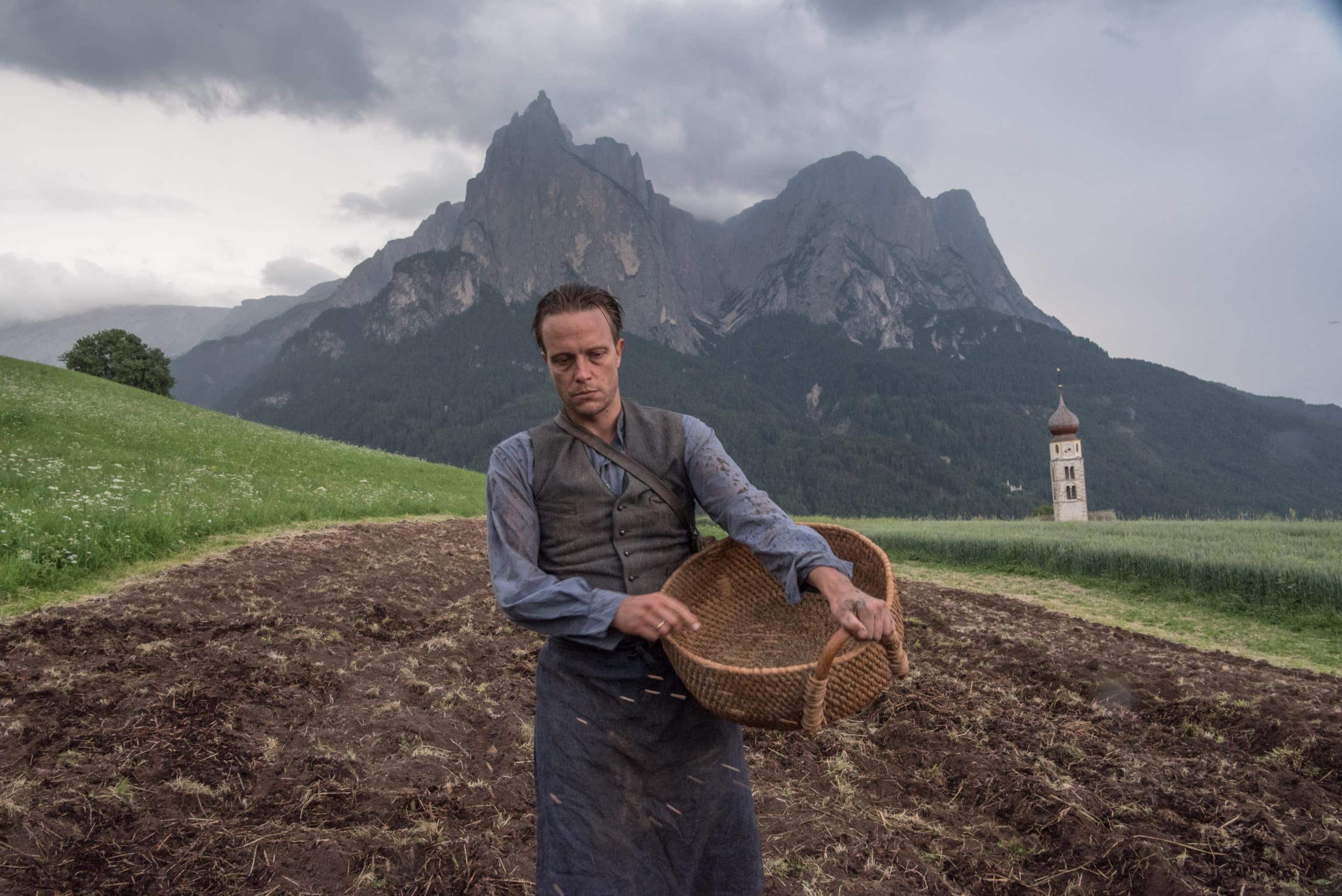

August Diehl and Valerie Pachner in the film A HIDDEN LIFE. Photo by Reiner Bajo. © 2019 Twentieth Century Fox Film Corporation All Rights Reserved
Cut from black-and-white newsreel footage of Nazi motorcades — Hitler carried on a float through a rally — to an Arcadian, postcard existence, a world away. ’It seemed no trouble could reach our valley,’ Fani tells us in hushed voiceover. ‘We lived above the clouds.’
It seemed no trouble could reach our valley, Fani tells us in hushed voiceover. We lived above the clouds.
Fani, her husband Franz, and their three little daughters live in Radegund, a farmstead in the Austrian alps, with a lonely white chapel, dwarfed by the sublime of sawtooth mountains that rise up another 2,000 feet. Clouds and fog creep and hang over the hills. Fani tilts her head to the infinite sky. An omen. The low hum of a plane overhead.
ArrayDuring the Second World War, it was mandatory for Austrian soldiers to swear an oath of loyalty to Hitler. A Hidden Life explores the real-life story of Franz Jägerstatter, who refuses this oath, resulting in his imprisonment and his family’s ostracism from the community. Faith squeezed on all fronts by ideology.
Terrence Malick’s is a searching cinema. Asking questions, inciting rather than insisting. Often deviating from or ditching scripts, the immediacy and subjectivity of character fills the frame in the absence of plot. Though A Hidden Life marks a return to script, the film has a freeform and spontaneous core.
Terrence Malick’s is a searching cinema. Asking questions, inciting rather than insisting.
The characters search, as Malick’s actors search for character. The camera observes, as if in wait for those one-of-a-kind moments, while the location manager is tasked with finding landscapes equal to reflecting interior ones. The prevalence of voiceovers in Malick’s films — themselves full of rumination and questions — seems less for the audience’s benefit, to root us in the narrative, than for the characters themselves to feel out the possible directions they might take in their own life’s arc.
Like Malick’s other films, A Hidden Life flows on montage. Stitching together scene-fragments that many film editors would treat as jetsam — transitional matter to be thrown overboard, streamlining the story — we are immersed in Franz and Fani’s experience, meted out in quotidian gesture. Scythes swishing in sync. A daughter toddling after a chicken. The peeling of an apple. The lonely labour of working the land — tilling fields that stretch off to oblivion — and the simple, tender acts of love and play — Franz chucking a clump of hay in Fani’s face, before gathering her up in a hug.

Valerie Pachner in the film A HIDDEN LIFE. Photo by Reiner Bajo. © 2019 Twentieth Century Fox Film Corporation All Rights Reserved

August Diehl in the film A HIDDEN LIFE. Photo by Reiner Bajo. © 2019 Twentieth Century Fox Film Corporation All Rights Reserved
With wide-angle lenses, the banal and the transcendent are crammed together in one frame, held in tension; you, like Franz and Fani, never lose sight of a force far greater than them. There is ominousness in a sky so vast and in the wind tousling a wheat field — especially when the lens distorts them both to seem so close-yet-far from us. Franz and Fani are connected with the earth, always under their fingernails. While that other element, fire — notably a low shot of villagers ambling around burning logs under a darkening sky — alludes to the burning of books and bodies, elsewhere.
Franz and Fani are connected with the earth, always under their fingernails.
Nature is everywhere, until it isn’t. Franz is imprisoned, confined to four walls and a rec yard, in which speaking is forbidden. The Nazi officers who torment Franz act as his foils. Just as Franz is not depicted particularly as a hero — more as an everyman — these officers are interchangeable and unremarkable. Their acts, on the other hand — from Franz’s conscientious objection to the guards’ blind obedience to the Führerprinzip — are utterly exceptional.
ArrayWhen Hannah Arendt coined the phrase ‘the banality of evil’, she was in part naming and condemning this failure to think (‘He did his duty…; he not only obeyed orders, he also obeyed the law.’) Indeed, when Franz appeals to a priest, he is told, ‘You have a duty to the fatherland. The church tells you so.’
What separates Franz from almost everyone else around him is his ability to think for himself; so Malick’s style — itself pensive, ambient, searching — is leveraged towards engaging our hearts to moral ends. Consider the amount of times Malick makes us feel that Franz’s refusal is selfish, vain, and pointless — even when you know, you know, that he’s standing up, in his own small way, to perhaps the greatest evil of the 20th century.

Valerie Pachner and August Diehl in the film A HIDDEN LIFE. Photo by Reiner Bajo. © 2019 Twentieth Century Fox Film Corporation All Rights Reserved
In this, Malick is like the church painter who Franz visits early on. ‘I help people look up from those pews and dream,’ the painter says. ‘They look up and they imagine that if they lived back in Christ’s time, they wouldn’t have done what others did.’ The painter thinks they would have.
Would we always know the right thing to do? Let alone be strong enough to do it? A Hidden Life will have you searching for the answers to these questions, and more. If you saw xenophobia, racism, and ugly nationalism encroaching on the simplicity of your life, would you do something about it? What if it was only for all the thanks a cloud gets when it drifts across the sky?
Array



